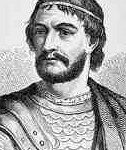
Date of Birth
720
Place of Birth
Perrancey, Haute-Marne, Champagne-Ardenne, France
Towns / Cities Moved Into
Perrancey, Haute-Marne, Champagne-Ardenne, France |
Marolles-sur-Seine, Seine-et-Marne, France |
Landkreis Darmstadt-Dieburg, Hessen, Germany
Known Occupation
Comte d'Autun & de Bourgogne
Lord of Perrecy, Montisan & Hesburg
Religion
-
Spouse
Bertha (Aube) d'Autun
Death Information
Year of death
9 Oct 768
Place of death
Landkreis Darmstadt-Dieburg, Hessen, Germany
Cause of death
-
Obituary

Parents

Count Childebrand I Of Austrasia Deperracy

Emma Vonaustrasia
Marital Status


Married Bertha (Aube) d'Autun
Children









Narrative / Story
Lord Nivelon I “The Historian” De Perracy, a prominent figure in the tapestry of medieval European history, was born circa 720 in Perrancey, Haute-Marne, Champagne-Ardenne, France. His life, marked by significant socio-political changes, offers a fascinating glimpse into the era’s complexities. As the son of Childebrand I de Perracy, Duke of Burgundy, and Chrodelinde d’Autun, Nivelon was born into a world where lineage and nobility dictated one’s path.
Nivelon’s life was deeply intertwined with the feudal system that dominated medieval Europe. As Comte d’Autun & de Bourgogne and Lord of Perrecy, Montisan, and Hesburg, he wielded considerable power and influence. His responsibilities would have included managing lands, overseeing justice, and maintaining the king’s peace in his territories. This period was characterized by a rigid social hierarchy, and as a member of the nobility, Nivelon would have been deeply involved in the political and military affairs of his time.
His marriage to Bertha (Aube) d’Autun was not just a union of two individuals but also a strategic alliance that would have strengthened his political position. Together, they had children, including Childebrand III de Perracy, count of Autun; Théodebert, count of Madrie; and Nibelung II. Family was a central aspect of Nivelon’s life, serving both as a source of personal joy and a means to secure his legacy and influence.
Nivelon’s life was marked by significant migrations, a common occurrence in medieval Europe due to various socio-political and economic reasons. He moved from his birthplace in Perrancey to Marolles-sur-Seine, Seine-et-Marne, France, and eventually to Landkreis Darmstadt-Dieburg, Hessen, Germany. These moves were likely driven by the need to manage and oversee his vast estates and fulfill his duties as a lord.
The era in which Nivelon lived was a time of great change and turmoil. The death of Charles Martel in 741 and the subsequent division of the Frankish kingdom between Pepin the Short and Carloman marked a period of significant political restructuring. As a noble, Nivelon would have been directly affected by these events, possibly participating in political and military campaigns.
Nivelon’s contribution to history extends beyond his political and military roles. He continued the writing of the Chronique de Frédégaire, a significant historical document, upon the death of his father. This work, completed in 768, the year of Pepin the Short’s death and Charlemagne’s accession, highlights Nivelon’s role as a historian and his contribution to our understanding of the period.
His death on October 9, 768, in Landkreis Darmstadt-Dieburg, Hessen, Germany, marked the end of an era. The burial location and details of his death remain a part of the historical mystery surrounding his life. Nivelon’s life, marked by his roles as a noble, a historian, and a family man, reflects the complexities and dynamics of medieval European society.
In terms of socio-economic issues, as a member of the nobility, Nivelon would have been largely insulated from the hardships faced by the lower classes. However, he would have been acutely aware of the responsibilities that came with his status, including the need to protect his lands and people during times of war and strife. The feudal system, with its rigid class structures, would have influenced every aspect of his life, from his political decisions to his personal relationships.
Life in medieval Europe was governed by a complex web of feudal obligations and loyalties. As a lord, Nivelon would have had to navigate these relationships carefully, balancing the demands of his overlord with the needs of his vassals and tenants. The period was also marked by frequent conflicts, both within kingdoms and between different realms, and as a noble, Nivelon would have been expected to participate in these conflicts, either by providing troops or by fighting himself.
In conclusion, Lord Nivelon I “The Historian” De Perracy’s life was emblematic of the era’s nobility. His roles as a lord, historian, husband, and father were interwoven with the socio-political fabric of medieval Europe, reflecting the complexities and challenges of the time. His legacy, preserved through his contributions to historical documentation and his lineage, continues to offer valuable insights into a pivotal period in European history.